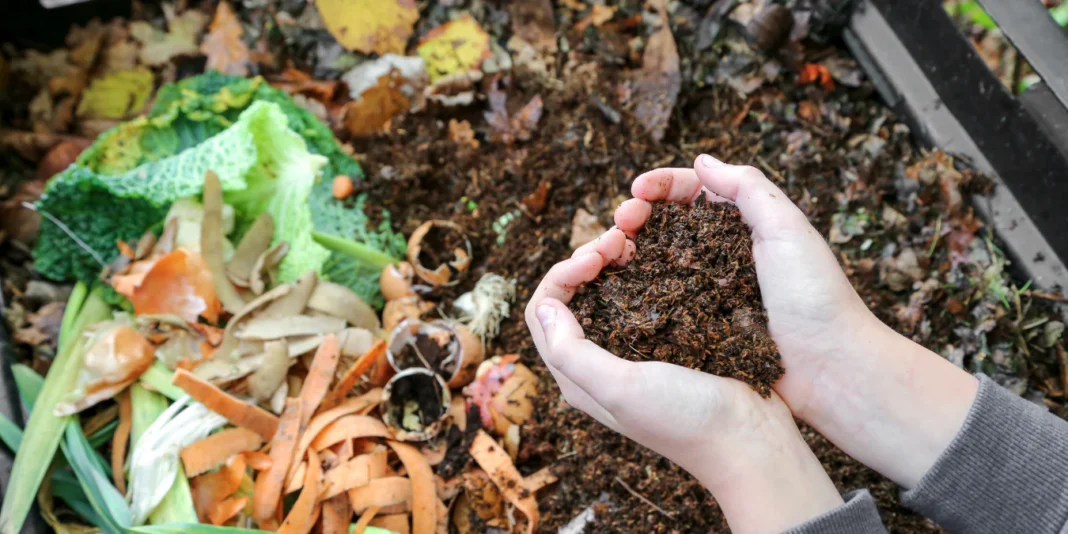The Benefits of Composting and How to Start
By Cora Gold
Composting promotes a circular economy in which waste is recycled for soil nourishment. If you want to try it, here’s a beginner’s lesson to help you turn spoils into an organic fertilizer for your garden.
Upsides of Composting
Recycling your household trash has both macro and micro benefits.
Reduced Landfill Waste
Thrown foods comprise 24% of landfill waste, contributing to methane emissions that worsen negative climate impacts. By creating an organic waste mound in your backyard, you can divert a portion of the trash from landfills and minimize its environmental impact on the planet.
Cost-Effective Fertilizer
If you have a spacious backyard, you can create a compost heap at zero cost. This will give you rich, loamy soil without spending hundreds of dollars on bags of mulch.
Otherwise, you can get affordable compost bins. Some hardware stores sell them for less than $200, while countertop models cost below $100. These containers are a great way to practice your skills for growing plants at home. You can put in your food scraps, paper towels, and lawn clippings.
Cleaner Plumbing Pipes
You save yourself from the headache of a clogged drain by throwing fruit peels into a pit instead of flushing them down the sink. If vegetable scraps and coffee grounds quickly fill up your kitchen containers, collect them for recycling. You’ll have fertile soil for your crops and keep your pipes debris-free.
Chemical Free-Yields
You harvest organic yields with compost. Some fertilizers contain toxins that may pose health risks if you eat the produce or ingest the chemicals leaching into waterways. Composting is the opposite, as it’s a safe and eco-friendly method to nourish the soil, allowing you to grow fruits and vegetables without harmful substances.
Food Independence
If you compost on a larger scale, you can grow your own crops and give your household complete control over the food supply. It promotes self-sufficiency.
Getting Started With Composting
If you’re a beginner, follow these steps to create a compost system at home successfully.
1. Choose a Bin
Compost cases come in various sizes and shapes. Holding units are ideal for apartment dwellers. The downside is the pile takes six months to two years to mature and be ready for use. Portable bins are perfect for moving between your kitchen and garden during waste collection. Turning units look like rotatable barrels. The key to picking the correct bin is to look at your available space and composting goals. A holding unit is your best bet if you don’t have a backyard.
2. Know the Compost Ingredients
What goes into your bin? The main components of an organic pile are browns, greens and water. Dead leaves and twigs are classified as browns, while grass clippings and coffee grounds are greens. You can toss almost everything into your compost heap except for meat, bones, dairy products, and things that attract animals.
3. Pick a Location
Find a good place for your waste mound. Preferably, you’d want it near your kitchen so you can toss the scraps without walking far in case it rains or snows.
4. Layer Your Compost Pile
It would help if you had the right proportions of organic trash to build a nutrient-rich pile. Lay the foundation with a four- to six-inch layer of twigs, wood chips, and other browns. Follow it up with greens, then browns again. A good ratio is at least two to three parts of browns in every volume of greens.
5. Maintain the Compost Pile
Use a garden fork to turn the mixture occasionally. Doing so speeds up the breakdown of waste. If it looks too dry, add a little water to increase moisture.
6. Use Your Compost
The pile is ready for use when it shrinks to about one-third of its original volume. This process may take about three to five months. You can harvest it when it smells like fresh soil, and the chunks of waste are no longer visible.
Troubleshooting Odor Problems
You may find the pile emitting foul odors. There are two ways to address this: first, fix the ratio of browns to greens, and second, turn the compost frequently.
Browns, like shredded paper, are rich in carbon, while grass clippings are greens containing nitrogen. The right balance of these elements helps minimize or prevent nasty odors from forming during decomposition. The pile should be about 30% greens and 70% browns. Add whatever waste is lacking to control the smell.
Another solution is to mix the compost more often. This creates enough gaps within the pile for oxygen to pass through and ventilate the materials, reducing the awful stench.
Start a Compost at Home
You don’t need to be a seasoned gardener to start a compost system in your backyard. Follow the steps above to do it like a pro.
About the author: Cora Gold is a sustainability writer who aims to live a healthy, low-waste lifestyle. Read more from Cora in Revivalist magazine, LinkedIn and Twitter.
